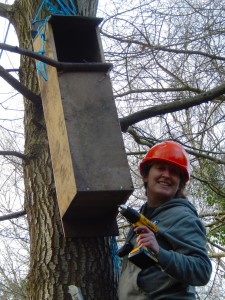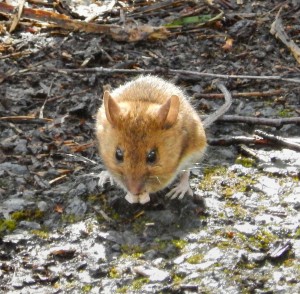
Monthly Archives: March 2015
Cetti’s, Chiffchaffs and Chaffinches at Wraysbury Lakes
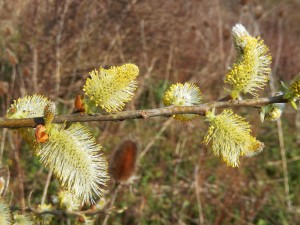
Amongst the chilly weather brought by the East Wind, today has at least been sunny, and out of the wind pleasantly warm.
Down at Wraysbury Lakes, plenty of Chiffchaffs, presumably mostly recently arrived from Spain or Africa, are now singing. The other migrant warblers have not yet arrived – if they think it’s too cold, who can blame them – so the only other warbler singing is the robust, secretive Cetti’s, calling from across the lake.
Apart from them, a flock of cheerful Jackdaws fluttered about the horse meadow; each mare had a new foal, wobbly on its new legs. A few Goldfinches and Chaffinches sang bravely. A Crack Willow’s buds gleamed silver, the green just starting to show; a solitary Pussy Willow (Sallow) shone golden against the dry brown scrubby area, last year’s dried Teasels still tall and handsome. Some Poplar branches gleam orange-yellow with Common Orange Lichen.
Scything the Anthill Meadow, Gunnersbury Triangle
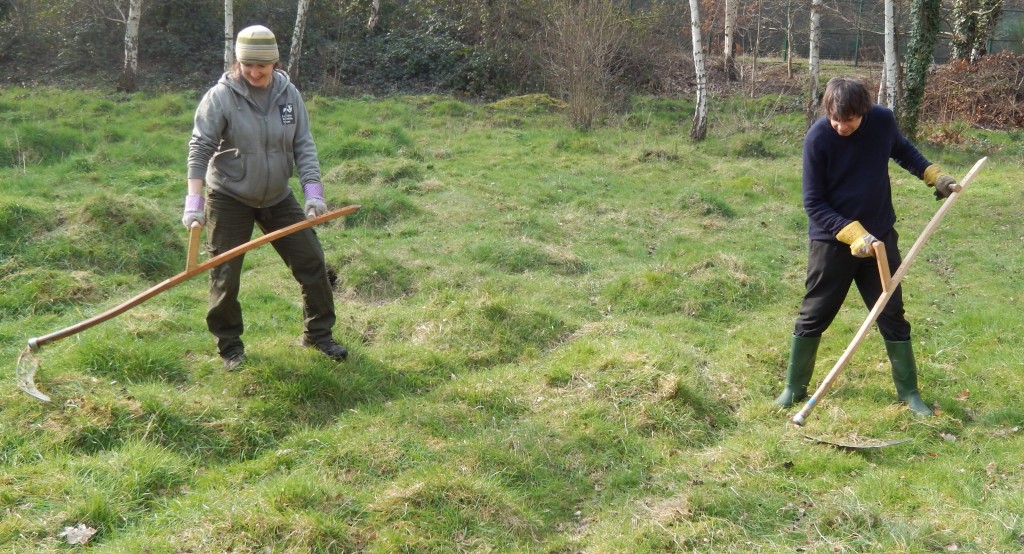
Spring, as in so many years, seems to be coming and going. Today, despite a gloomy forecast, the sun came out, coats came off, the Chiffchaffs started to sing, and we went happily to work in the sunshine. We fixed a new rail to mark off a Forest School area as “not a path”, despite appearances: we rigged it up with a hinge one end and a keeper – posh name for a pair of bits of batten screwed on to the post – to hold the rail the other end when it’s in the down position. We cleared up a vandalized loggery, using the stray bits of log and lots of cut ivy to block off an undesired path, and filled in the hole.
And then we all had a lesson in scything – you have to put the thing together to fit your height and arm length. The main pole is ingeniously not quite straight; the two handles each fit on with a bolt; the blade fits on with a lug and two grub screws in a metal housing. It sounds a bit fiddly and it takes a little time to adjust it, but when you have it exactly right, it’s a pleasure to use, and astonishingly light to swing. The blade needs to be sharpened every few minutes to keep it slicing effortlessly through grass, which contains silica (aka sand) and quickly blunts blades. But, well-maintained, the scythe is a remarkably efficient tool, and environmentally friendly. Contrary to expectations, it does not cause strain or backache, and people large and small can use it effectively. It’s trickier on bumpy ground covered in anthills. Five of us mowed the picnic meadow and the anthill meadow in an afternoon: it was no quicker (and a lot noisier) with the brushcutter. We disturbed a small frog or two, and accidentally scraped a small toad that was hiding in the long grass, but it wasn’t seriously hurt.
On the common I heard a Mistle Thrush calling, and a flock of Goldfinches. A party of Long-Tailed Tits visited the garden. Red and White Deadnettles are in bloom; Cow Parsley is coming into fresh leaf.
Angle Shades Emerging (it’s springtime)
It’s spring! Well, a Blackcap sang its cheerful spring song to me yesterday, in my garden, how about that, after flying all the way from Africa. Today, a Chiffchaff sang (and briefly appeared) in the nature reserve while I was working down at the frog pond.
And back at home, as I was watering the garden, I saw this Angle Shades moth (Phlogophora meticulosa, a Noctuid) in its final ecdysis, inflating its wings from their crumpled state inside the overwintering pupa. It was on the pipe insulation of the garden tap.
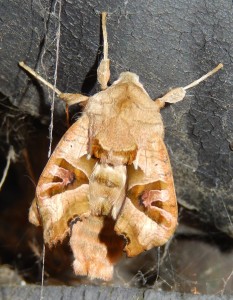
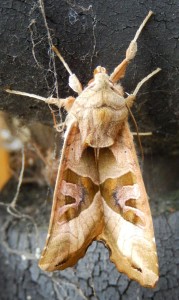
Presumably the moth’s body clock said “It’s spring”. Amazing to watch.
Signs of Spring, and Muntjac, at Wraysbury Lakes

Suddenly it feels like spring. The migrant warblers haven’t arrived, though a resident Cetti’s gave me a fine burst of its loud simple song; and the winter ducks haven’t all gone back up North, a few Goldeneye and Goosander still fishing the lake; but it was almost warm in the bright sunshine, and the wild pear tree in the woods positively sparkled with fresh new blossom.

There were animal tracks too: tiny footprints of Muntjac.
A little further, a fresh pile of tiny scat, Muntjac for sure.
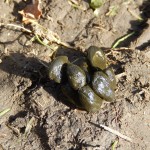
A Sparrowhawk dashed low over the willows, and disappeared as swiftly as it had arrived.
On the path, the much larger slots of Roe deer; and a Rabbit hopped quietly aside.
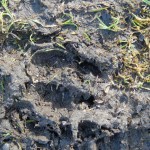
The last of the winter thrushes – a flock of Fieldfares – called their chattering chack-chack from the tall boundary hedge of trees. A flock of gently twittering Goldfinches, too, served as a reminder of a winter only just passing.
Not every day I’m seen wheeling a bench about a nature reserve
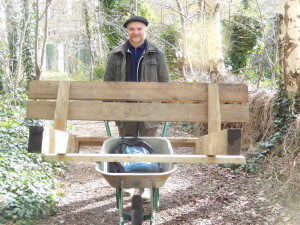
Well, it’s not every day one wheels a robust two-legged bench about a nature reserve. The team of three however managed to think of a way of balancing the bench on a wheelbarrow using a bit of four-by-two to prop up the legs, and thus poised it turned out to be quite easy to trundle along, carefully dodging trees and bushes along the way.
The holes were just the right depth, so all we had to do was drop in the bench, level it, pour in some water and add rapid-setting post concrete. The bit we had left turned out not to be enough, so after struggling in vain with additional pebbles, we propped it up and those with bicycles went round to the hardware store to fetch some more concrete. Second time proved lucky, the ‘crete set like custard without enough milk added, and very soon we were shovelling the spoil into the holes and stamping it down.
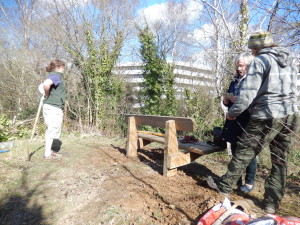
Owl Box for Gunnersbury Triangle
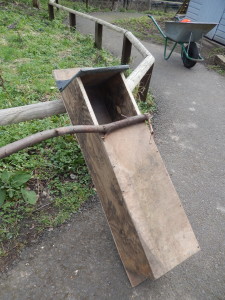
It was a very rainy workday, and with only two of us around we wondered what to do. It was time for an indoor project that we’d been putting off … make an owl box. Tawny Owls might seem surprising citydwellers, but they are around in the leafier suburbs and larger parks.
We looked at the RSPB website for instructions, calculated the measurements of all six faces of the box on a sheet of paper, and studied the bits of plywood we had available. Just whiz along with the circular saw, screw it all together and we’ll be done.
It took a little longer. To cut the wood, we needed to be outside. Where it was raining. The wood got wet and it was hopeless trying to draw lines in pencil or biro. Felt pen worked, sort of, but gave us thicker smudgier lines. We drew, went outside, held and sawed, dusted down, came inside, made another cup of tea, drew again, went outside.
Finally we had a forlorn pile of long, dirty, improbably shaped bits. They seemed nothing like a nestbox. Let’s finish it next time, said Netty, sounding a lot less keen than she had at the start. Let’s get it done, I said. It’ll not take long now. We were a bit cold. We screwed the front to the sides, which were the thickest parts. Suddenly it had a shape. We took the extraordinarily long back and screwed it to the sides. A box. A very long box. We pushed the base into the hole. It wobbled. We pushed it down the very long hole with an umbrella and got some screws in. It was all done save the lid, which needed waterproofing with some roofing felt, and attaching with a rubbery damp-course hinge.
The next time was dry, and we took the box outside. It seemed enormous, and Netty had fixed on a long bit of dead branch as an owl-perch, but it went in a wheelbarrow and we set off with drill, ropes, and a ladder to the chosen Oak, a tall straight tree off the beaten track.
We managed to get a rope over a branch and haul the box up. Only, how to fix it and get the rope down again? We let it down, threw a thin plastic rope over the branch as well, hauled the box up, tied the thin rope onto the top of the box, and stood back. The box was up, but definitely dangling. We could easily fix some screws into the stub at the base of the box, but how to do the same for the stub at the top? We moved the ladder around the tree to find a way to reach. With the ladder in the easiest place, the box was directly above our heads. We tried it every which way, we couldn’t reach. We put the ladder back where it was. With two of us holding the ladder and one on the top rung, it was just possible. Trying to tie knots or fix a screw with one hand … is quite tricky. We were very pleased when it was done. We’ll be delighted if a family of owls takes up residence. Or even some jackdaws.
